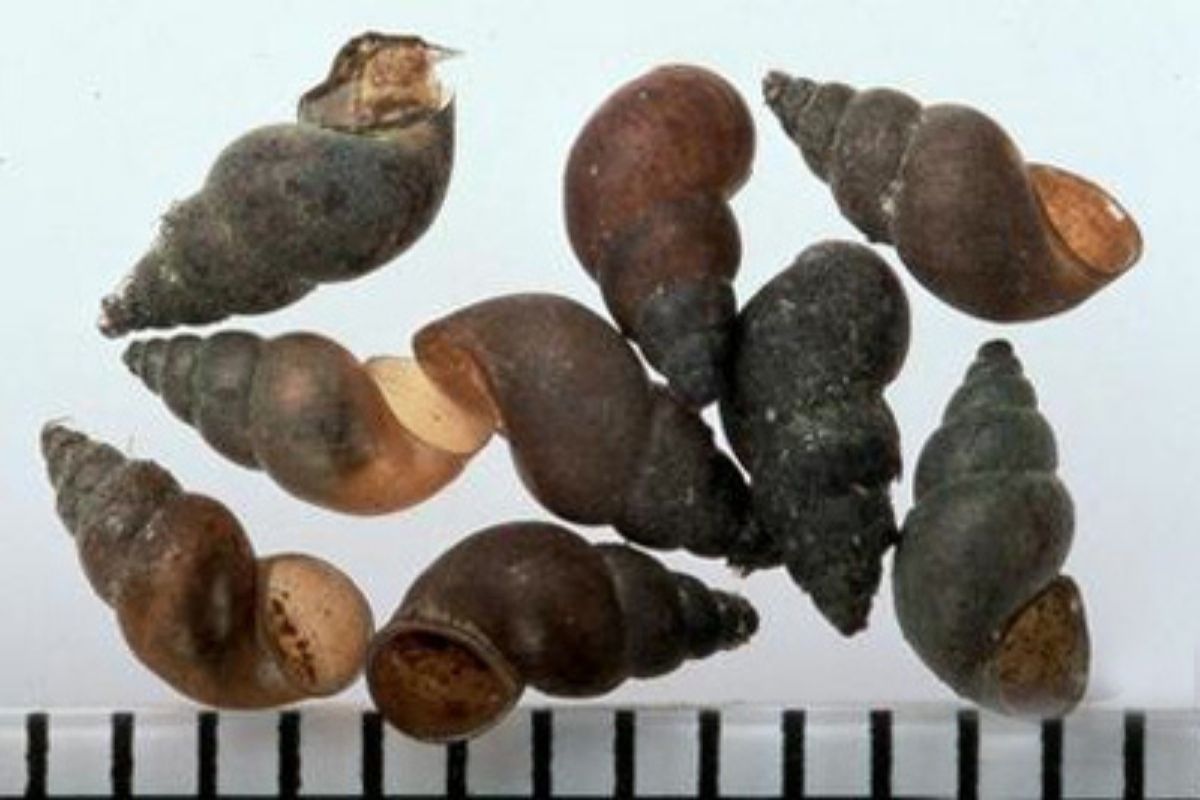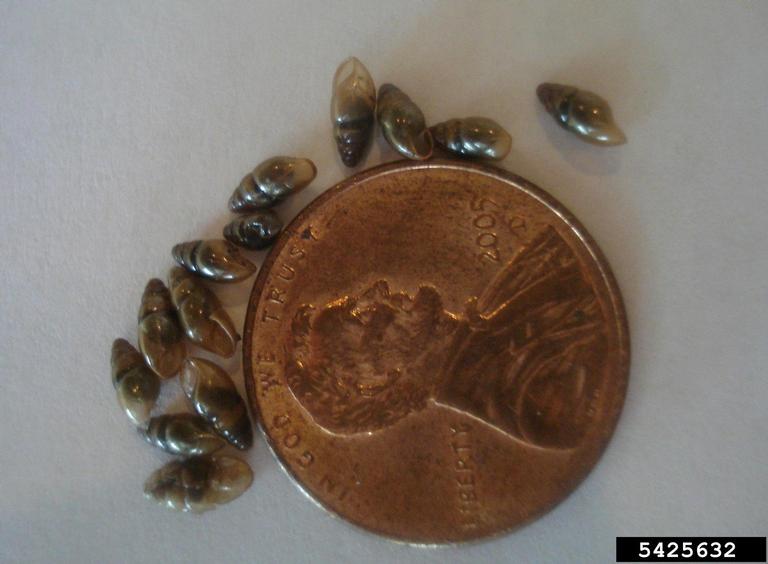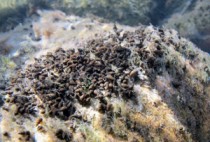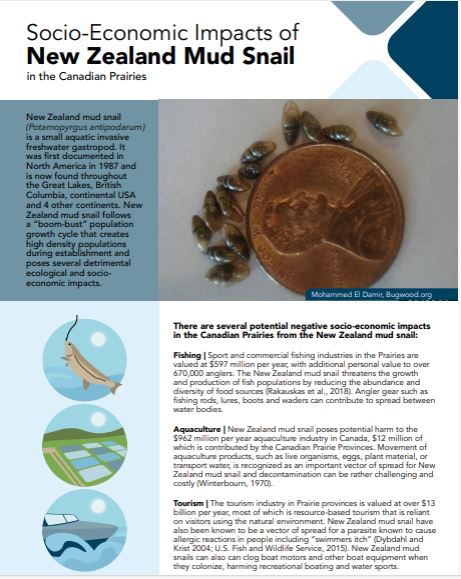New Zealand Mud Snail (Potamopyrgus antipodarum)

Photo: Mike Gangloff, Bugwood.org

Photo: Mohammed El Damir, Bugwood.org
Order: Littorinimorpha
Family: Tateidae
Did you know? In just one year, a single female New Zealand mud snail can form a colony of 40 million snails.
Introduction
New Zealand mud snails are aquatic snails that can be found in waterways including lakes, rivers, and streams. Their high reproductive potential, coupled with their ability to consume up to half of the food available to native mollusks and insects, allow New Zealand mud snails to quickly out-compete other species and pose a significant threat to the balance of ecosystems. Consequently, these invasive snails can threaten biodiversity by disrupting the food chain and reducing the growth capacity and population sizes of native aquatic species.
New Zealand mud snails are characteristically resilient, which has enabled them to sustain establishments in new, foreign environments while putting stress on the health of ecological architectures in their non-native habitats.
As their name suggests, these tiny species of mollusks are native to New Zealand and its neighbouring islands. Through contaminated ballast water and with the help of terrestrial wildlife, New Zealand mud snails are shameless hitchhikers that have been proliferated globally because of their ability to thrive in new territories.
They were first introduced to North America in 1987, and have since spread as far as Australia, Europe, and Asia. This includes establishment into the five Great Lakes, and the provinces of British Columbia and Ontario (U.S. Fish & Wilflife Services).
General Information
New Zealand mud snails are extremely tiny, freshwater snails that may grow to be only a fraction of the size of an American penny. Their grey or brown shells contain 7-8 whorls which are usually six millimeters in length, distinguishably narrow and long compared to native snail species (Canada).
This species of mollusk has a solid operculum and may have spines in the middle of each shell whorl. Morphologically, male and female New Zealand mud snails are very similar (CABI).
New Zealand mud snails are distinctly male and female, however virtually all invasive establishments are parthenogenetic female clones. In other words, females produce fertilized eggs without the need for a mate. These eggs hatch in a brood and are ready to move on as juveniles.
The snails lack a planktonic larval stage which increases their ability to be naturally transported. Females, who reproduce in both the spring and the summer each year, yield 20-120 young per brood and can produce a total of 230 young per year (Therriault et al., 2010).
In their native range, New Zealand mud snails are only found in freshwater, whereas in their non-native range, they are found in both freshwater and saltwater ecosystems. In their non-native range, mud snails have been recorded in a variety of waterways including streams, rivers, lakes, channels, shallow lakes, and open seas (CABI).
Contrary to their namesake, mud snails are not only found in the mud; they are also located on rocky surfaces, aquatic vegetation, or wooden debris (U.S. Fish & Wildlife Service).

Due to the rapid reproduction rate of the New Zealand mud snail, the first sign of an infestation is an overwhelmingly large mass of them.
In addition to the snails’ ecological impacts through their ability to outcompete other invertebrates for resources, they can also pose economic and municipal threats by clogging water intake pipes with infested water (Michigan State University).
The costs of New Zealand mud snail invasion can be considerable due to the damage they produce and the amount of labour to remove them.
As implied by its name, New Zealand mud snails are native to New Zealand. The invasive mud snail was first discovered in the Snake River, Idaho in the 1980’s. They arrived via contaminated ship ballast water, and have since spread rapidly throughout North America (U.S. Fish & Wildlife Service).
As a result of their small size and their ability to survive out of water for long periods of time, these snails can also be transported by birds, wildlife, footwear, hip waders, and small watercrafts, which is problematic in managing their proliferation.
New Zealand mud snails are resilient, small in size, and have great reproductive success, and ultimately distribute very rapidly (Department of Fisheries and Oceans).
The extreme reproductive success of the New Zealand mud snail means that they have the capacity to reach some of the highest densities ever reported among stream invertebrates. This can cause them to alter the entire nitrogen fixation rate of an ecosystem, significantly diminishing the health of a region. They achieve this by collectively consuming a high quantity of green algae, which alters nitrogen levels in the ecosystem.
New Zealand mud snails may also out-compete native mollusks for both space and food sources because of their large, overwhelming colonies, therefore reducing the growth of native species.
Fish may consume these tiny snails, but because New Zealand mud snails are categorically resilient, they may survive the journey through the digestive system of fish. Fish that consume the snails will tend to lose weight rather than gain weight because the mud snail is still alive in the digestive tract of the fish (CABI).
There are currently no specific eradication methods to prevent the introduction of New Zealand mud snails. Preventative techniques are important in the prevention and control of these invasive snails (CABI).
Some prevention techniques may include:
- Sanitary and Phytosanitary (SPS) measures and early warning systems (treatment of ballast water and examination of aquaculture products)
- Rapid response once an introduction is confirmed
- Public awareness campaigns targeted at anglers, fish farm owners, hunters, hikers, etc.
- Promote to and encourage anglers to carefully clean their equipment and waders
- Monitoring and surveillance for the detection of New Zealand mud snails in aquatic ecosystems
By becoming aware of the effects of this aquatic invasive species, along with the measures that can be taken to prevent their establishment, our water systems can be protected from New Zealand mud snails.
If you see a colony or individual invasive mud snail, report your sightings here.
Research
Further Reading
The Invasive Species Centre aims to connect stakeholders. The following are information links below link to resources that have been created by external organizations.
Michigan State University: New Zealand Mud Snail

